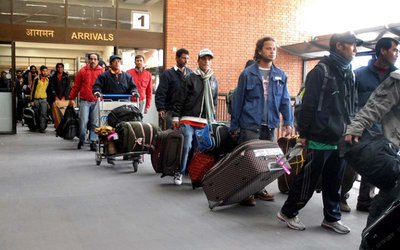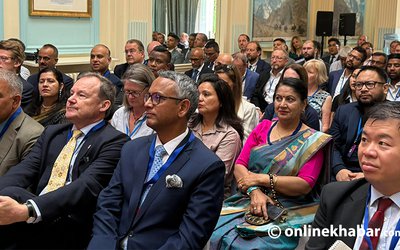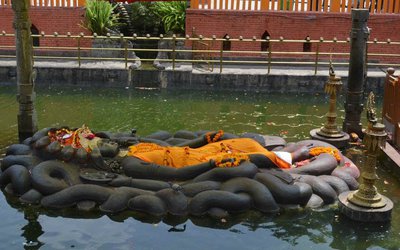
Republic India’s Nepal Policy:
The departure of the British in August 1947 gave birth to the two dominions of India and Pakistan. However, the unshackled India continued the colonial policy of the British, claiming to be the heir of the British India Empire – an empire that created the Johnson/Ardagh (Aksai Chin) and McMahon Lines in India's western and eastern Himalayas. In fact, India’s policies regarding Nepal, Sikkim, Bhutan, Jammu & Kashmir, Hyderbad, Tripura etc. were far more stringent than that of the colonial British. The Jammu & Kashmir claims led to the 1948 Indo-Pakistan war resulting in a United Nation brokered cease-fire guaranteeing referendum for the Kashmiris. As for the Nizam of Hyderbad, “police action” was resorted to for which India “loaned ” 10,000 Nepalese troops to assist the hard-pressed Indian Army. Regarding Nepal, as early as March, 1950, Prime Minister Nehru declared in the Indian Parliament “….Nepal, almost geographically a part of India, though an independent nation…..it is not possible for any Indian Government to tolerate any invasion of Nepal from anywhere.” With that strategy framed for Nepal, Nehru had the Treaty of Peace and Friendship duly signed in July 1950 with the tottering autocratic Rana Prime Minister, Mohun Shumshere. The 1947 departure of the British had left the Rana regime high and dry, bereft of their century-old benefactor. The shrewd Nehru, however, played the role of the mediator, cobbling up the February 1951 coalition government between the Ranas and democratic forces with Mohun Shumshere still as Prime Minister. When the coalition government collapsed after nine months, Mohan Shumshere took refuge in Bangalore’s Paradise Valley, with history etching his name as the last Rana Prime Minister of Nepal.
Matrika Prasad Koirala, on the other hand, had his name etched as Nepal’s first democratic Prime Minister in November 1951. Many believe he was anointed by Nehru. So when Nehru caught cold in Delhi, Matrika naturally sneezed in Kathmandu. Thus, MP Koirala, during his four year Premiership, performed the tasks as instructed by Delhi. The following were some of the major tasks: i) not trusting his own, he invited Indian security forces into Nepal three times (twice to apprehend the ‘Red Bandit’, Dr. KI Singh and the other that assassinated Bhim Dutt Pant in Far West) ii) invited the Indian Military Mission for reorganizing the Nepalese Army from 25,000 to 6,000, an army that had fought during the Second World War and assisted India during her critical hours. The Mission, originally scheduled for one year, continued to stay on indefinitely until forced out in 1970 iii) "loaned" the Indian military personnel to man the “17 wireless stations” on the Nepal-Tibet border that was also forced out in 1970 iv) hastily signed the 1954 Kosi Treaty that his own half-brother, BP Koirala, severely criticized. The one major task that Prime Minister Nehru failed to fulfill through his anointed man was the endorsement by the Nepalese Cabinet of the May 1954 Aide Memoire that stated “….Indian Missions abroad will undertake to represent the Government of Nepal and to look after Nepalese interests….. exchange information relating to foreign affairs and relations with foreign power…”.
Troubles on the Indo-Tibetan Border:
After having the signed Treaty of Peace and Friendship in his pocket (as for the secret Letters of Exchange, so damaging were the clauses that Nehru deemed it necessary to disclose them only nine years later in December 3, 1959), Nehru stated in the Indian Parliament on December 6, 1950 ‘…our interest in the internal conditions of Nepal became still more acute…..because of the developments in China and Tibet….the Himalayas ….principal barrier to India lies on the other side of Nepal and we are not going to tolerate any person coming over that barrier.’ With the Khampas' rebellion in Tibet and the Dalai Lama fleeing to India in March 1959 and the Sino-Indian Hindi-Chini Bhai Bhai relationship plummeting, the watch on Nepal intensified. The disputes over the Aksai Chin and McMahon Line became acute, with India adopting the policy of "…dispatching properly equipped patrols into the areas occupied by the Chinese…. ". This resulted in the first spark of the border war in Aksai Chin's Longju in August 1959 when Indian troops intruded and fired on Chinese border guards. A far more serious encounter occurred in October 1959 at the Konka Pass where India's paramilitary border force suffered nine killed and seven taken prisoner. On the Nepalese front too, Chinese troops in June 1960 fired at a Police party killing one and capturing seventeen others believing them to be Tibetan Khampas. An enraged Nehru declared from Delhi that the Chinese attack on Nepal was an attack on India also. Prime Minister BP Koirala, however, skillfully handled this incident stating that Nepal, as an independent sovereign nation, was capable of tackling it herself .
India’s 1961 Forward Policy:
Prime Minister Chou En-lai accompanied by his Foreign Minister Marshall Chen Yi visited Nepal and India in April 1960. The Mount Everest ownership figured at the Kathmandu talks. In India, when the border talks made no headway during his six-day visit, Chou En-lai is supposed to have finally offered Nehru "You keep what you hold, you take too anything that is in dispute and occupied by neither, and we keep what we hold." The Chinese made clear that they were prepared to accept the McMahon Line in the east provided the Indians also accept the Chinese control line in the west (Aksai Chin). India disagreed and instead at a meeting in Prime Minister Nehru's office on November 2, 1961 the Army Chief, General PN Thapar, proposed that the Army should quickly move forward to fill the space between the two side's lines of actual control because otherwise the Chinese would do so within a few months. The Intelligence Bureau along with the Foreign Ministry concurred. This, thus, became India's Forward Policy strategy. General BM Kaul, who was then Chief of the General Staff, is supposed to have told Neville Maxwell that the Forward Policy was actually his conception "sold to Nehru over the head of Krishna Menon." But after the 1962 debacle, General Kaul retracted and shifted the blame on Nehru, Menon and his military superiors. The following are the directives of that Forward Policy where Nepal's Kalapani/Limpiyadhura got entangled:
(a) So far as Ladakh is concerned we are to patrol as far forward as possible from our present positions towards the international border. This will be done with a view to establishing our posts which should prevent the Chinese from advancing any further……. This must be done without getting involved in a clash with the Chinese unless this becomes necessary in self-defence.
(b) As regards UP [Uttar Pradesh i.e the middle sector] and other northern areas, there are not the same difficulties as in Ladakh. We should, therefore, as far as practicable, go forward and be in effective occupation of the whole frontier. Where there are any gaps they must be covered either by patrolling or by posts.
While the Nepal "loaned" Indian military personnel at 17 listening posts diligently reported all Chinese activities from Walungchung Gola in the east to Tinker in the west to the Indian Embassy at Kathmandu, India belatedly realized the strategic importance of Nepal's Kalapani/Limpiyadhura on her UP middle sector front. Kalapani, thus, became the unfortunate casualty of India's 1961 policy "to go forward and be in effective occupation of the whole frontier". The wily British, recognizing the importance of the Tibetan trade route through the Lipu Lekh Pass, had already resorted to several "cartographic aggressions" during their rule in India. But actual "physical aggression" had never occurred.
Physical Aggression of Nepal’s Kalapani:
As the result of India's 1961 Forward Policy, the Sino-Indian war broke out in October 1962. “The Indian forces in NEFA [commanded by General BM Kaul were badly mauled and the Chinese seized virtually the entire area on the Ladakh-Tibet border that was in dispute.” The battered Indian forces respected the unilateral ceasefire announced by the Chinese. It appears that the "physical aggression" of the strategic Kalapani/Limpiyadhura area by the Indo-Tibetan Border Police (ITBP) occurred only after India's October 1962 debacle. This validates the statement of the veteran 94 year old journalist, Bhairav Risal, that he had, in early 1961, taken the census of the villages in the Kalapani areas, east of the River Kali. There were no Indian security forces there at that time.
Conclusion: Letter and Spirit of the Treaty
To conclude, India, after unshackling herself from the colonial British rule in 1947, desperately tried to colonize Nepal to securitize her northern frontier. To a large extent, she was successful through the tottering Rana regime or the anointed Prime Ministers. This policy went astray when King Mahendra took over the reign in December 1960. India, distinctly unhappy with the King, resorted to the first economic blockade and supported the Nepali Congress' armed forays into Nepal's Terai. The 1962 Sino-Indian border war was, hence, a blessing in disguise for Mahendra. It is said that the King was aware of the Kalapani occupation and most probably he was. But with the disgruntled India and the Nepali Congress breathing down his neck, the shrewd King was probably waiting for an opportune moment. With the China-humbled more amenable India, King Mahendra did amend the 1959 Gandak Treaty in 1964 and revise the 1954 Kosi Treaty in 1966. In 1970, King Mahendra did finally boot out the Indian Military Mission and the India-manned 17 wireless posts on the Nepal-Tibet border.
Regarding Kalapani’s villages of Gunji, Nabi and Kuti (east of the River Kali but now under Indian occupation), the then Acting Chief Secretary, J Adams, in 1817 had instructed his Kumaon Commissioner, GW Trail, that ‘The letter and spirit of the Treaty of Peace give to the Nepalese Government to the undoubted right to all lands situated to the eastwards of the Kali…….it is extremely undesirable to manifest any reluctance to give prompt and full effect to those stipulations of the Treaty…….’ By including Nepal’s Kalapani in her recent maps, India is again resorting to that unfortunate 1961 Forward Policy. It is sincerely hoped that the Government of India will respect Nepal’s “undoubted right and give prompt and full effect.”
Footnotes
The Durand Line that partitioned the Pashtu speaking people between Pakistan and Afghanistan.
After the First Anglo-Sikh War of 1846, the British annexed Jammu and Kashmir that belonged to the Sikhs. While the Sikhs had made the Dogra Chief, Gulab Singh, Rajah of Jammu only, the British went a step further by making Gulab Singh, a Hindu, Maharaja of the Muslim majority Kashmir as well – sowing the discontent seeds to the present!
This word 'loaned' is actually coined by Prime Minister Nehru himself while replying to the Parliament on the military personnel manning the ‘17 Wireless Posts’ on the Nepal-Tibet border.
Bhasin, Avtar Singh. 1994. Nepal's Relations with India and China. SIBA EXIM Pvt. Ltd. Delhi.
Rose, Leo E. 1971. Nepal Strategy for Survival. Oxford University Press. Bombay, Calcutta, Madras. Matrika, was considered to be more amenable than his more popular half-brother, BP Koirala.
From November 1952 (Mangsir 2008) to January 1956 (Magh 2012);
These 17 Indian-manned wireless stations stretched from Walunchug Gola/Taplejung in the east through Lamabagar/Dolakha, Kodari/Sindhupalchowk and Namche Bazaar/Mustang in the centre to Simikot/Humla and Tinkar/Darchula in the west. These stations reported to the Indian Embassy at Kathmandu.
Rose, Leo E. 1971. Nepal Strategy for Survival. Oxford University Press. Bombay, Calcutta, Madras.
Bhasin, Avtar Singh. 1994. Nepal's Relations with India and China. SIBA EXIM Pvt. Ltd. Delhi.
Maxwell, Neville. 1970. India's China War. Natraj Publishers, Dehra Dun, India.
China agreed to pay a compensation of Rs 50,000/-.
Maxwell, Neville. 1970. India's China War. Natraj Publishers, Dehra Dun, India.
Besides Nehru and his Defense Minister Krishna Menon, those present were: Foreign Secretary, MJ Desai, Chief of Army Staff, General PN Thapar with General BM Kaul, Intelligence Bureau Director, BN Malik and other officials as well.
Maxwell, Neville. 1970. India's China War. Natraj Publishers, Dehra Dun, India.
Maxwell, Neville. 1970. India's China War. Natraj Publishers, Dehra Dun, India.
Rose, Leo E. 1971. Nepal Strategy for Survival. Oxford University Press. Bombay, Calcutta, Madras.
Incidentally, the Indo-Tibetan Border Police was created only in October 1962!
Rose, Leo E. 1971. Nepal Strategy for Survival. Oxford University Press. Bombay, Calcutta, Madras.
This 1959 Gandak Treaty was signed during BP Koirala's premiership. As far as Nepal's water right is concerned, the Treaty is extremely one-sided.

Santa Bahadur Pun
Pun is a former MD of NEA
- Deputy Prime Minister And Water Resources Minister Shailaja Acharya As I Knew Her
- Aug 22, 2023
- Reflections on Cross Border Electricity Trading: South Asia/BBIN versus ASEAN Model
- Jul 03, 2023
- A Short History Of The 300/900 MW Upper Karnali Hydroelectric Project
- Apr 18, 2023
- The Story Behind: 200/600 MW of Electricity Wasted, No Buyers Yet!
- Nov 08, 2021
- Booker Talliaferro Washington (Born: April 5, 1856, Died: November 14, 1915)
- Sep 16, 2021












